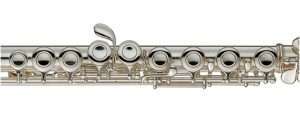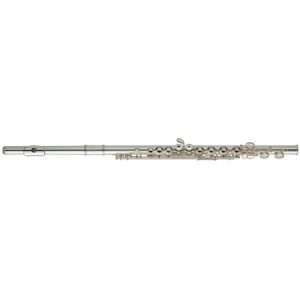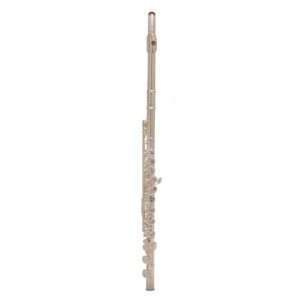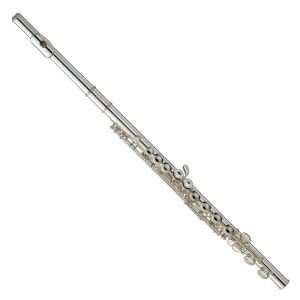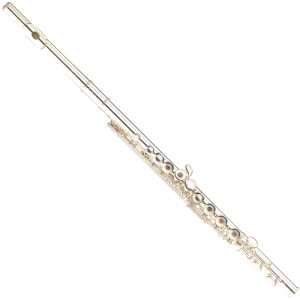
How to choose a flute
Contents
Flute (Italian flauto from Latin flatus – “wind, breath”; French flûte, English flute, German Flöte) is a woodwind musical instrument of the soprano register a. The pitch on the flute changes by blowing (extracting harmonic consonances with the lips), as well as by opening and closing holes with valves. Modern flutes are usually made of metal (nickel, silver, gold, platinum), less often – from wood, sometimes – from glass, plastic and other composite materials.
Transverse flute – the name is due to the fact that during the game the musician holds the instrument not in a vertical, but in a horizontal position; the mouthpiece , respectively, is located on the side. Flutes of this design appeared quite a long time ago, in the era of late antiquity and in ancient China (9th century BC). The modern stage of development of the transverse flute begins in 1832, when the German master T. Boehm subjected it to improvement; over time, this variety replaced the previously popular longitudinal flute. The transverse flute is characterized by a range from the first to the fourth octave; the lower register is soft and deaf, the highest sounds, on the contrary, are piercing and whistling, and the middle and partly upper registers have a timbre that is described as gentle and melodious.
Flute composition
The modern flute is divided into three parts: head, body and knee.
Head
In the upper part of the instrument there is a side hole for blowing air (muzzle or embouchure hole). In the lower part of the hole has some thickenings in the form of lips. They are called “sponges” and, contributing to greater stability during the game, they prevent excessive loss of air. There is a plug at the end of the head (it must be handled carefully when cleaning the instrument). With the help of a wooden cap placed on it, the cork is pushed tightly inward to a greater or lesser depth in order to take the correct position, in which all octaves sound exactly. A damaged plug should be repaired in a specialist workshop. The flute head can be changed to improve the overall sound of the instrument

Body
This is the middle part of the instrument, in which there are holes for extracting sound and valves that close and open them. The valve mechanics are very finely tuned and should be handled with care.
Knee
For the keys located on the knee, the little finger of the right hand is used. There are two types of knee: Do knee or Si knee. On a flute with a C knee, the lower sound is C of the first octave, on flutes with a C knee – C of a small octave. The C knee affects the sound of the third octave of the instrument, and also makes the instrument somewhat heavier in weight. There is a “gizmo” lever on the C knee, which is used in fingering up to the fourth octave. The design of the flute
valve mechanism can be of two types: “inline” (“in line”) – when all the valves form one line, and “offset” – when two salt valves protrude.
Although the difference lies only in the position of the valve G, depending on this, the setting of the performer’s hand as a whole changes significantly. Professional players of both types of flutes claim that the in-line design allows for faster trills , but the choice really comes down to which option you’re most comfortable with.
inline |
offset |
Children’s flutes
For children and students with small hands, mastering the instrument can be difficult. With this in mind, some children’s models have a curved head, which allows you to easily reach all the valves. Such a flute is suitable for the smallest musicians and those for whom a full-fledged instrument is too large.
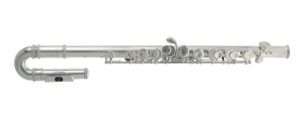
John Packer JP011CH
Teaching flutes
Flute valves are open (with resonators) and closed . As a rule, in training models, the valves are closed to facilitate the game. Contrary to a common mistake, the flute does not sound out of the end, so the difference in playing with open and closed valves drastically affects the sound. Professional musicians play instruments with open valves, as this greatly expands the possibilities of applying various effects, for example, a smooth transition from one note to another or a quarter step up / down.
Open valves |
closed valves |
Both children’s and educational models are most often made of an alloy of nickel and silver, which is more durable than pure silver. Due to its exquisite luster, silver is also the most popular finish, while nickel-plated flutes are less expensive. Those who are allergic to nickel or silver are advised to choose a flute made from a non-allergic material.
Flutes of advanced and professional level
Transitioning to a more advanced flute with open valves can be tricky. To facilitate this transition, temporary valve plugs (resonators) are provided that can be removed at any time without any damage to the instrument. However, keep in mind that mutes limit the ability of the flute to resonate at full force.
Another difference in more advanced instruments is the design of the knee. The lowest sound of flutes with the C knee is the C of a small octave. Implemented by adding an additional third valve C. In addition, a gizmo lever is added, which makes it much easier to extract notes up to the third octave. This is the highest note that can be played on a flute without going over the upper register . It is very difficult to play clean up to the third octave without the gizmo foot.
Professional flutes use much better materials and French-style keys (with extra soldering on those keys that the finger does not press directly on), providing extra support, better grip, and a more attractive appearance. Precise mechanics ensure fast response and flawless smooth operation.
Flute Varieties
There are several varieties of flute: piccolo (small or sopranino), concert flute (soprano), alto flute, bass and contrabass flute.
concert flutes
The soprano flute in C is the main instrument in the family. Unlike other families of wind instruments, such as the saxophone , a musician does not exclusively specialize in the alto, bass, or piccolo. The main instrument of the flutist is the soprano flute, and he masters all other types in the second turn. Other varieties of the flute are not constantly used in the orchestra, but only add shades to a particular composition. Thus, mastering the concert flute is the most important stage in learning.
Alto flutes
The alto flute is often found in an orchestra. Its specific low timbre adds fullness to the sound of higher woodwinds. In terms of structure and playing technique, the alto flute is similar to the usual one, but it sounds in the G scale, that is, a fourth lower than the soprano flute. The experience of playing the alto flute is very important for a professional musician, since many solo orchestral parts are written specifically for this instrument.
bass flutes
The bass flute is rarely used in orchestral music and appears, as a rule, in flute ensembles. Because they belong to the same family of instruments, flute quartets, quintets and larger ensembles are very popular among intermediate and advanced students.
Due to its large size, it is rather difficult to achieve a clear sounding bass flute – this requires a high professional level and a keen ear for music. However, there are other (albeit rare) instruments in the flute family that have an even lower sound – these are the contrabass and subcontrabass flutes. Both of them are also used exclusively in flute ensembles. These flutes are placed on the floor and the performer plays while standing or sitting on a high stool.
Piccolo flutes
The piccolo (or piccolo), the smallest instrument in the family, sounds a whole octave higher than the concert flute, but has the same C tuning . It may seem that the piccolo is just a smaller copy of the soprano flute, but this is not so. The piccolo is more difficult to play because its sharp, high timbre requires forced airflow, which a beginner flutist cannot create. In addition, the proximity of the valves can also create difficulties for a beginner.
Piccolo flutes come in several varieties:
1) Metal body + metal head
– ideal for a marching ensemble;
– has the brightest sound with maximum projection;
– air humidity does not affect the sound (lack of wooden flutes)
2) Body and head made of composite materials (plastic)
– the strength of the instrument is an important factor for beginner musicians;
– weather conditions do not affect the sound quality
3) Wood body + metal head
– ideal for a beginner mastering the piccolo flute ;
– the design of the sponges facilitates the formation of the air flow;
– metal head provides less air resistance
4) Body and head made of wood
– best of all provide melodic sound;
– sound quality depends on external conditions;
– frequent demand in orchestras and most wind ensembles
Flute Overview
Flute examples
Conductor FLT-FL-16S |
John Packer JP-Celebration-Flute MK1 Celebration |
YAMAHA YFL-211 |
YAMAHA YFL-471 |






